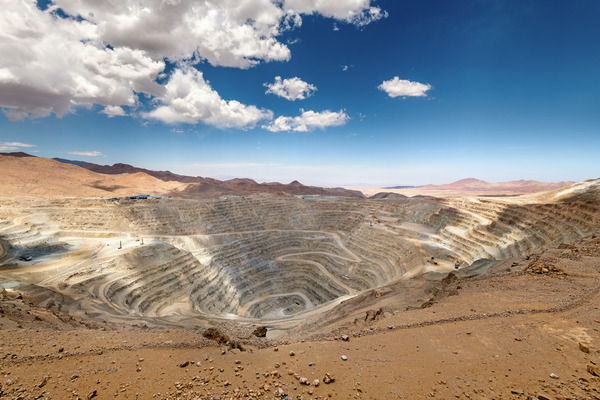The mining sector’s largest company by market capitalization is BHP Group Ltd. (BHP). And, unlike its peers, this mining giant is growing by sticking to its proverbial knitting.
BHP is using its healthy balance sheet both to buy smaller miners and to build organically, but the company has kept to well-traveled paths. This year’s $6 billion OZ Minerals buyout, for example, has added copper reserves near the company’s Olympic Downs mine in South Australia. And, BHP is also getting out of dead-end assets like coal. The company plans to sell its stakes in two metallurgical coal mines in Queensland for $4 billion, following the spin-off of its oil and gas assets into Woodside Energy Group Ltd. (WDS).
With its reshaped and more focused portfolio, BHP’s recent share price weakness offers an opportunity to own a company that will be more compelling later this decade—not to mention one that still pays out a healthy dividend.

Near-Term Pain
Even with a relatively strong iron ore price, investors have shied away from BHP over the past year. The stock is down 13%, with most of that drop occurring in the first weeks of 2024. This points to skepticism that a price of more than $120 a ton for iron ore can hold, given the shakiness in the Chinese construction sector.
Bear in mind, though, that most of the price of iron ore is gravy for BHP. In the 12 months leading up to the end of June 2023, BHP’s costs were less than $18 per ton at its Western Australian operations, which it boasts is the most efficient of the major players.
BHP’s latest results were okay. Operationally, the company had a solid first half of its fiscal year. Western Australia iron ore production was up 5% quarter-on-quarter, while first-half copper production rose 7%. This reflected a record half at BHP’s Spence mine in Chile as well as ongoing strong performance and additional tons at collected at Copper South Australia mines. Despite this, BHP has reduced its dividend payout to its shareholders from 75% of its earnings to around 65%.
Nevertheless, BHP’s future looks bright. Here’s why…
BHP’s Three Focus Areas
BHP is becoming a more focused company, emphasizing three core areas: iron ore, copper, and potash.
Nickel had been an emphasis as well, but this is changing due to the collapse in the price of nickel—down 45% over the past year due to oversupply thanks to a flood of nickel exports from Indonesia. It would not surprise me to see a potential writedown of BHP’s Nickel West division. That would not be overly material to the company, as the metal forms a small part of its overall portfolio.
BHP’s iron ore assets are industry-leading and accounted for nearly 60% of the company’s 2023 fiscal year cash profits. BHP remains well placed to continue its low-cost production and increase output with minimal expenditure, thanks to its efficiency.
BHP enjoys a $5 more per ton in free cash flow than that reported by its largest competitor. Expansion is planned for its key Pilbara iron ore complex, with output on route to medium-term capacity of 305 million tons, and eventually 330 million tons.
Regarding copper, the outlook here is even brighter. Few mines have been built in recent years, and demand will climb thanks to electrification worldwide. This will result in a significant supply deficit by 2027, when prices should average $10,000+ per ton, up from the current $8,250 per ton. BHP’s growing copper output therefore looks well timed, thanks to the aforementioned OZ deal. If approved, the acquisition could add around 200,000 tons of copper a year by 2030.
Finally, there is potash. BHP’s next mega-mine for this mineral compound is the Jansen fertilizer project in Saskatchewan, Canada. The company expects production at Jansen to begin in late 2026; once fully ramped up, Jansen will become one of the world’s largest potash mines, producing approximately 8.5 million tons per year. In the latest quarter, construction of the Jansen mine in Canada was ongoing and there was approval of Jansen Stage 2 ($4.9 billion), which doubles planned potash production capacity.
While the return of Russian and Belarusian exports to the market this past year pushed potash prices down, they are still well above BHP’s forecast production price of $115 per ton at the new mine. There are some worries in the market that the huge new mine will depress prices, but it is likely Russian supply drops—due to geopolitics—as demand rises.
Buy BHP
Free cash flow in the 2023 fiscal year was $12.0 billion, after record highs of $25.2 billion in 2022 and $20.1 billion in 2021. In the 2024 fiscal year, I expect $11 billion to $12 billion in free cash flow.
My forecast is for fiscal 2024 dividends of $1.80 per share, about 6% higher than last year. BHP stock is a buy around $60, giving it a 5.5% yield.
Financial Adviser Reveals “Secret Map” He’s Using to Retire His Family
The last time such a rare situation happened with this “secret map” was in 1984. When one stock skyrocketed for all-time gains, that resulted in $5,000 turning into $108,850… and $25,000 into $544,250! Now it’s even bigger. Click here before it's too late.





